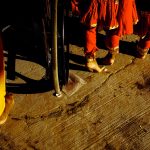Pasajes I
2012 - Film & Video (Film & Video)
12:30 minutes
Sebastián Díaz Morales
Pasajes I is the first in a series of Sebastián Díaz Morales’s four videos Pasajes , which focuses on a solitary man walking through Buenos Aires. He walks through churches, shops, and libraries—accessing completely different interior spaces simply by going through doors. The seamless editing allows the man to transcend locations: after he enters a house from a busy intersection he emerges in the halls of a school. Through our guide we catch glimpses of the city, making the video an intriguing tour of the Argentine capital. We experience different lives, wealth, and employment. Never stopping to take in his surroundings, or to question where he’s going, he keeps on walking relentlessly—a possible allegory for man’s continued searching and struggle for something better and something more. It enforces an idea of progress, never sleeping, and the quest to always move on. The smart officious clacking of shoes of our guide recalls a businessman, flowing around the city, unable to leave. When this film was made, Argentina had imposed controls on movements in their territorial waters in order to block foreign companies drilling for oil, and was experiencing a period of economic growth before a period of harsh austerity. In Pasajes I we experience a complete freedom of movement, to all facets of society. Prosperous locations are accessed via underprivileged ones, and vice-versa. Díaz Morales flattens out these rudimentary distinctions, the city is an ecosystem where everything is symbiotic.
Raised in an isolated location between the Atlantic Ocean and the Patagonian Desert, Sebastián Díaz Morales believes his upbringing led him to a very particular way of perceiving the world around him. Using different filmic techniques, from narrative film-like works to found-footage, he explores the relationship between large-scale socio-political power dynamics and individual objectives. His films are often surreal, include no dialogue, and create a tension between reality, fiction, and representation in a visually abstract way. Morales’s films and videos are oftentimes surreal where social reality is reflected in a form that is visually abstract and fantasy-based. Most of his works study the relationships between a large-scale socio-political power and the actions of individuals; they reflect the interactions between people and their environment and social structures. The methods that Morales uses are twofold – in his works he uses both prepared scripts and the uncertainties of real life. His camera is focused on capturing documentary material, but he also uses footage that is experimental and that comes from the realms of science fiction.
Colors:
Related works of genres: » video artists, » video artist, » born 1975, » contemporary artist
» see more

© » KADIST
Diana Thater
2005In Perpetual Motion (2005) the seemingly erratic flight of the bright orange Monarch butterfly—filmed in its winter habitat of Michoacán, Mexico—is intensified by the artist’s editing in which frames are randomly dropped and the film is sped up...

© » KADIST
Cildo Meireles
1975Meireles, whose work often involves sound, refers to Sal Sem Carne (Salt Without Meat) as a “sound sculpture.” The printed images and sounds recorded on this vinyl record and it’s lithographed sleeve describe the massacre of the Krahó people of Brazil...
Related works featuring themes of: » Argentinian
» see more

© » KADIST
Pablo Accinelli
2011In Onde quer que voce esteja (2011) Accinelli sets up a row of cardboard shipping tubes of varying heights and inscribes on them in black ink the words of the title, which translates in English as “Wherever you may be.” The words, while legible, seem like fragmented lines and shapes—almost but not quite a deconstruction of the text...
Other related works, blended automatically
» see more

© » KADIST
Sebastián Díaz Morales
2014In Suspension a young man is hanging in the air, falling, or perhaps drifting through time and space...

© » KADIST
Pablo Accinelli
2011In Onde quer que voce esteja (2011) Accinelli sets up a row of cardboard shipping tubes of varying heights and inscribes on them in black ink the words of the title, which translates in English as “Wherever you may be.” The words, while legible, seem like fragmented lines and shapes—almost but not quite a deconstruction of the text...
Related works sharing similar palette
» see more

© » ARTS EQUATOR
Air Con: Who Do You Want To Be When You Grow Up? | ArtsEquator Thinking and Talking about Arts and Culture in Southeast Asia ArtsEquator Viewpoints October 8, 2021 By Dhinesha Karthigesu (1,330 words, 5-minute read) Who do you want to be when you grow up? At the end of the play AIR CON , the character William (Nick Davis) asks the character Asif (Ryan Lee Bhaskaran) this question...
Other works by: » Sebastián Díaz Morales
» see more

© » KADIST
Sebastián Díaz Morales
2014In Suspension a young man is hanging in the air, falling, or perhaps drifting through time and space...
Related artist(s) to: Sebastián Díaz Morales » Agustín Pérez Rubio, » Akram Zaatari, » Liu Wei
» see more

© » KADIST
Akram Zaatari
1966“People often asked if they could pose with the Kodak advertisement where a full scale woman is featured with a camera offering Kodak rolls...

© » KADIST
Akram Zaatari
1957“These are negatives that were scratched because of a jealous husband from the Baqari family, who never let his wife out by herself...

© » KADIST
Akram Zaatari
1950“In the 1980s I started using coloured paper backdrops, one of which was yellow...
Related works found in the same semantic group
» see more

© » KADIST
Julia Rommel
2015On the artwork, Rommel states: “I was reading Jonathan Franzen’s new novel Purity, where they take a lot of walks through the jungle in Uruguay, or Paraguay, I can’t remember...









